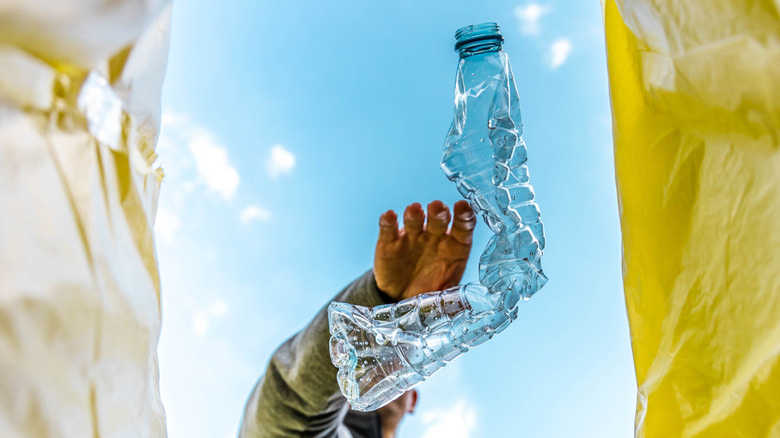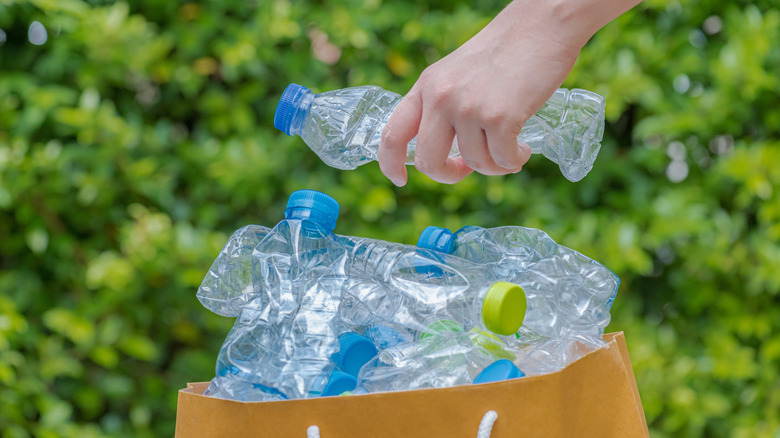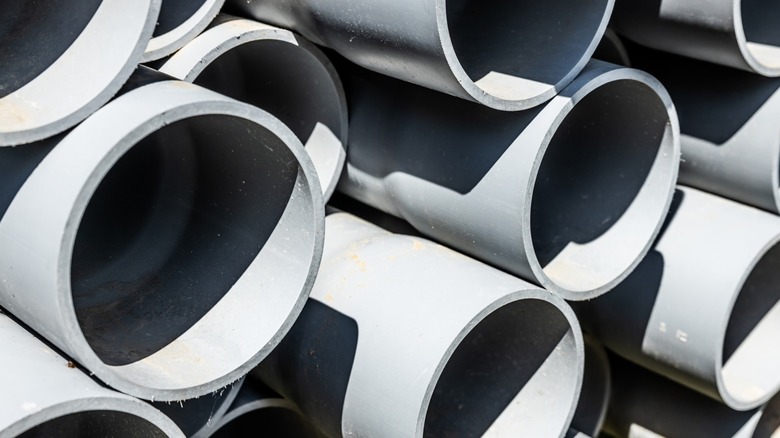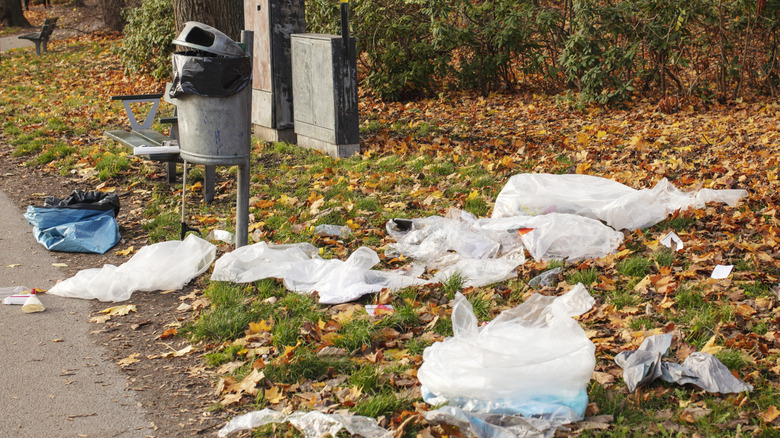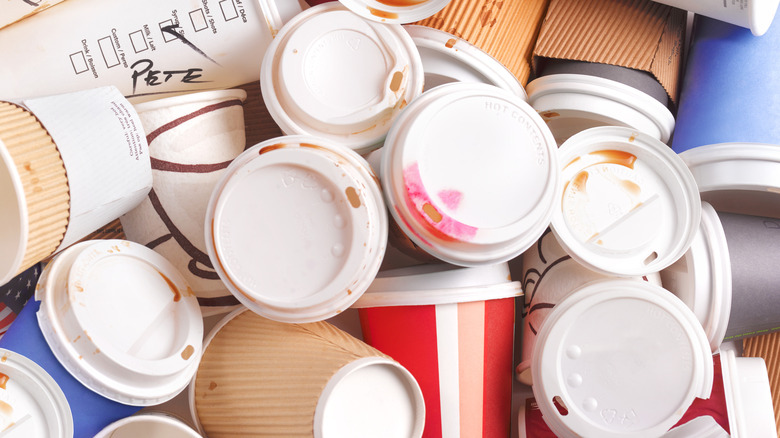Unexpected Uses Science Has Found For Your Plastic Trash
Plastic trash is a problem. In the USA, each person produces an average of 100kg of plastic waste per year. Single-use plastics like drink bottles, carrier bags, plastic straws, and disposable cutlery are filling up landfill sites and littering the world's oceans. It is important to reduce the amount of single-use plastics we use by shopping for sustainable products, choosing eco-friendly alternatives, and using reusable straws and cups.
But what about all the plastic that's already out there? Can it be put to good use? Thanks to developments and innovations by scientists, the answer is a resounding "yes," with plastics being recycled in a variety of surprising ways. This can be challenging. Nemi Vora, a research scientist who has authored a paper on recycling plastics, said to Berkeley Lab, "Plastics were never designed to be recycled. The need to do so was recognized long afterward." There are two main methods of plastic recycling: Mechanical and chemical. Mechanical recycling is simpler. Plastic is melted and reshaped into new products. Chemical recycling breaks plastic down into its basic components.
Before we look at how scientists are finding solutions for plastic trash, it's helpful to understand that plastic isn't just one type of material. It covers a bunch of a variety of materials, which are made differently, used for various things, and need to be handled differently if recycled or repurposed. In this article, we're focusing on four different types of plastic: Polyethylene terephthalate (PET), High-density polyethylene (HDPE), low-density polyethylene (LDPE), and Polypropylene (PP). We'll explain the differences and uses of each of them in the sections below.
Discarded plastic drinks bottles are being turned into clothes, shoes, curtains, and new plastic bottles
Plastic drink bottles are usually made of Polyethylene terephthalate (PET). This is one of the most common types of plastic used in single-use plastics and is also used for food packaging, like disposable plastic sandwich containers and cookie trays. To be mechanically recycled, PET waste needs to be collected, sorted, and cleaned. It is then shredded into small flakes, which are melted and turned into small pellets, which can then be turned into clothing, shoes, bags, and more plastic bottles.
The science of turning plastic trash into fabric was developed at the Massachusetts Institute of Technology in 2021 and has now become mainstream. You can buy fleeces made from 100% recycled polyester from Toad&Co, leggings made from 25 water bottles at the Girlfriend Collective, and shoes repurposed from reclaimed bottles from Salubata. Plastic bottles are also made into blankets, IKEA shower curtains, and wallets. There are also more surprising uses for your used bottles and other PET trash. Scientists at the University of Edinburgh have found a way to turn plastic bottles into vanilla flavoring by turning PET plastic into acid and feeding it to bacteria to convert it into vanillin. It's not even the first time scientists have discovered plastic-eating bacteria.
And there's more research into turning plastic into food. Scientists at Michigan Technological University have converted plastic waste into edible protein using specialized bacteria. It's only been fed to roundworms so far, and the lead scientist, Stephen Techtmann, accepts there's an "ick factor" for most when considering eating recycled plastic. On a more prosaic note, your discarded plastic drink bottle could simply be turned into another one. Many beverages are now sold in 100% recycled PET bottles, including Coca-Cola, Sprite, and Smartwater.
Plastic can be recycled into plant pots, pipes, and surfboard fins
Sturdier items like detergent bottles, bottle caps, and gas cans are made of High-density polyethylene (HDPE). HDPE is more resistant to degradation, so you can melt it, reform it, and have something of the same quality as the original. The environmental services company ESE World B.V. carried out tests that demonstrated that HDPE can be recycled ten times.
To be mechanically recycled, HDPE needs to be collected, sorted, shredded into small pieces, cleaned, melted, and formed into plastic pellets. On an industrial scale, it's used to make recycled plastic lumber, garden furniture, pipes, and agricultural feeding trays. Charities and entrepreneurs have made use of how easy it is to recycle HDPE. For example, an initiative in Colombia led by an organization called the Amigos del Mar Foundation collects plastic from beach trash and turns it into surfboard fins. You can also buy plant pots, earrings, and jewelry boxes made out of recycled HDPE on Etsy.
Scientists at the U.S. Department of Energy's (DOE) Institute for Cooperative Upcycling of Plastics (iCOUP) are also working on improving the HDPE recycling process by chemically breaking down HDPE to make recycled plastic which is even better than the original. It's even possible to make HDPE that is biodegradable in nature, but this research is still in its early stages.
Plastic Bags can be turned into bricks and music speakers
Bendy, stretchy plastic waste like flimsy carrier bags and food packing film presents a challenge to recyclers. It's made of low-density polyethylene (LDPE), and unlike HDPE, it's difficult to collect, sort, and recycle. LDPE needs specialized processing, making it harder to break down into reusable pellets, and many LDPE items, like plastic bags, get stuck in recycling machinery. This is why it is often not accepted in curbside collections.
Nevertheless, some enterprising inventors have found a good use for LDPE. In the UK, Gomi makes power banks and speakers using recycled plastic bags, and Nairobi-based initiative, Gjenge turns used LDPE and sand into paving bricks. It's also used to make mailing envelopes and more plastic bags. Most LDPE doesn't get recycled, though, and scientists are working hard to find ways to improve the situation. Scientists at the University of Madras in India have discovered that there's a type of algae that causes LDPE plastics to degrade naturally and could provide a potential eco-friendly solution to dealing with plastic waste.
Meanwhile, researchers at UC Berkeley have developed a process to break down LDPE into propylene, a raw material that can then be used to make other plastic products. Scientists also discovered a type of caterpillar able to eat and break down polyethylene. By changing its chemical structure, LDPE can also be repurposed as an adhesive.
Used coffee cups can be transformed back into their raw materials
Food packaging needs to be strong and heat-resistant, so items like hot beverage cups, ready meal packaging, and disposable cutlery that end up as trash are made out of a type of plastic called Polypropylene (PP). It's difficult to recycle for several reasons. Firstly, PP has a higher melting point and requires specific recycling processes. Secondly, PP waste is also often blended with other materials, which makes it harder to recycle. Plastic that can't be recycled through mechanical means is known as "end-of-life" waste.
Because of this, scientists are focused on ways to chemically upcycle PP by breaking it into its original chemical components. The same researchers at UC Berkeley, who have been working with LDPE, have also developed a process to turn PP back into a raw material. This method turns polypropylene back into propylene, which can then be used by the petrochemical industry in the same way as non-recycled material.
Innovative scientists have also found a way to turn PP trash into soap. A team at Virginia Tech heated PP in just the right way to produce fatty acids, which they then turned into bars of soap. Lead scientist Guoliang Liu said to The Guardian, "It's the first soap ever made from plastic in the world. It has a bit of a unique color. But it works."
